tube rolling
... on the floor laughing my freaking ass off ...
Basic Tube Facts
- • most tube matching occurs at a single test point. Apex match uses several points, but thus far only inexpensive tubes are Apex matched. Matching at several points should catch outlier tubes with erratic performance.
- • tube match point is seldom operational point
- • tube response is non-linear as all datasheets show. Responses are curves
- • datasheet response curves are design parameter and may not be actual performance for most tubes in a production run
- • tubes vary a few percent unit to unit when new and drift as they age
[The Mullard Story on UBoob is a fascinating insight into thermionic tube complexity] - • tubes begin to 'wear out', i.e. change, from the moment they are turned on
- • tube seals are not 100% and old tubes may take considerable time to de-gas and may never!
- • new tubes should run for at least 30 minutes with only their heaters powered to de-gas. Longer for NOS.
- • matched NOS maybe a fools errand given the variability measured unless they are proven NOT gassy over 24 hours
NOS Gassiness
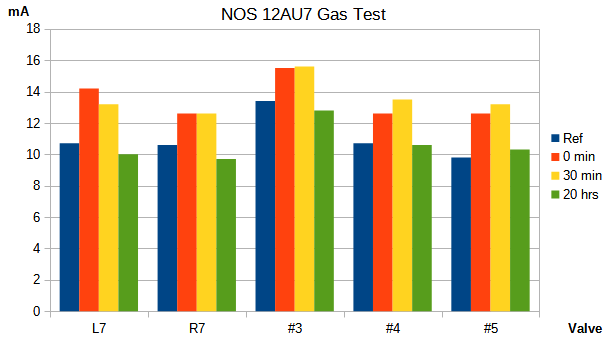
- Ref: Out of box @ -8.5vdc Sum of each triode tested individually
- 0 min: Both triodes enabled
- 30 min: Both triodes after 30 minutes
- 20 hrs: Both triodes after ≈20 hours on heater only.
Tubes stored for a long time become gassy. Glass is not impervious to air. Some tube materials outgas over time. Gas increases the risk of arcing. If the tube is not destroyed, the arc may consume the gas.
The graph shows the current change due to gassiness reduction for five NOS 12AU7 purchased from a well respected vendor. The current delta is not consistent. Some tubes decrease after 30 minutes while others increase. Both lead to additional non-linearities [distortion] other than those inherent in vacuum tubes. In contrast, new 12AU7 show ZERO change on gas test and consequently are more linear across the operational range.
The graph shows the current change due to gassiness reduction for five NOS 12AU7 purchased from a well respected vendor. The current delta is not consistent. Some tubes decrease after 30 minutes while others increase. Both lead to additional non-linearities [distortion] other than those inherent in vacuum tubes. In contrast, new 12AU7 show ZERO change on gas test and consequently are more linear across the operational range.
Socket Retension
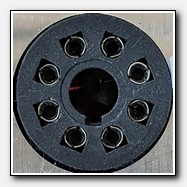
When there's a problem, someone always recommends retensioning tube sockets. In decades of tube amp ownership, never found it required. Check? Every six months after their semiannual check. Luckily, I have a set of Gauge Pins, so can select the exact 0.001" required.
Octal KT88 / 6550 / 6L6 style tubes have pins about 0.095" diameter. A 3/32" drill is 0.09375" diameter, the perfect 'go-nogo' checker. If the shank end of a 3/32" drill does not slide easily into the pin socket, the socket does not need retensioning.
Nonal tubes have 0.040" diameter pins. A #65 drill or #19ga solid wire make good go-nogo checkers.
Octal KT88 / 6550 / 6L6 style tubes have pins about 0.095" diameter. A 3/32" drill is 0.09375" diameter, the perfect 'go-nogo' checker. If the shank end of a 3/32" drill does not slide easily into the pin socket, the socket does not need retensioning.
Nonal tubes have 0.040" diameter pins. A #65 drill or #19ga solid wire make good go-nogo checkers.
If a socket does need retensioning, it may need replacing. Sleeve sockets should probably NOT be retensioned as the socket is flared and bending the top will reduce contact.
Excessive Rolling
"A hidden problem is that repeated plugging and unplugging can create micro-fractures in the glass near the pins, allowing just sufficient gas to leak into the valve to subtly degrade the vacuum, and increase ionization noise (for this reason, the British Standards Institution warned against repeated testing of special quality valves)." - Valve Amplifiers 4e - Morgan Jones p352
Matching
The image below is for 2x Gold Lion KT88 matched quads. It's highly suspect that 8 tubes would match Gm to zero parts in 7400. [All were labeled with Gm of 7400.] Measured after about a year at around 300 hours on a Hickok, they are close, but not identical.
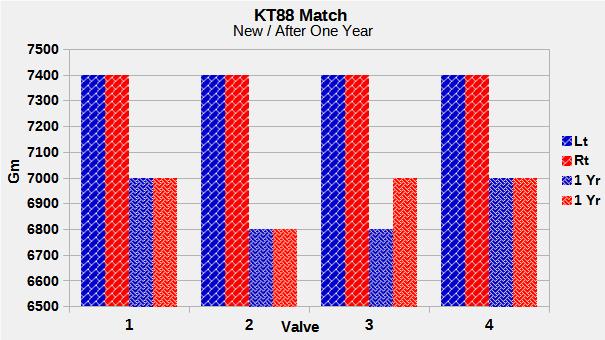
The image below is for 5x JAN6829 measured in a stock M-125 driver board. While they are close, they do vary within a trained listener's detectability.
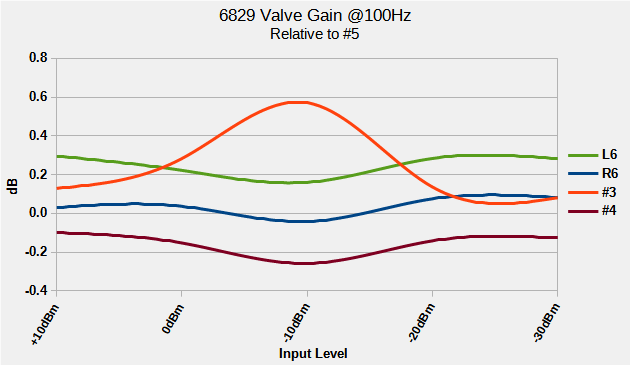
The images below are for 4x 5963 measured on a tube tester. NOT your Drug Store tube tester, but one where the exact operating parameters can be set and measured. See The Lab Icing These four tubes have TWENTY-FOUR possible combinations. Combined with line voltage, power supply, output transformer and everything else inside an amplifier, any hard and fast recommendations are highly suspect.
They are compared as might be used in a phase splitter. If the phase splitter is uneven, distortion increases and the second the delta between each half. They will not sound the same. [bigger? fatter? thinner? ????]
They are compared as might be used in a phase splitter. If the phase splitter is uneven, distortion increases and the second the delta between each half. They will not sound the same. [bigger? fatter? thinner? ????]
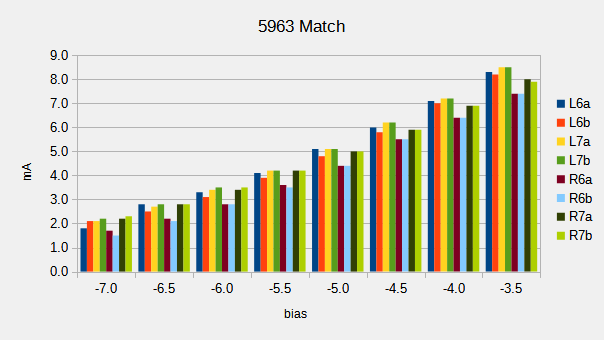
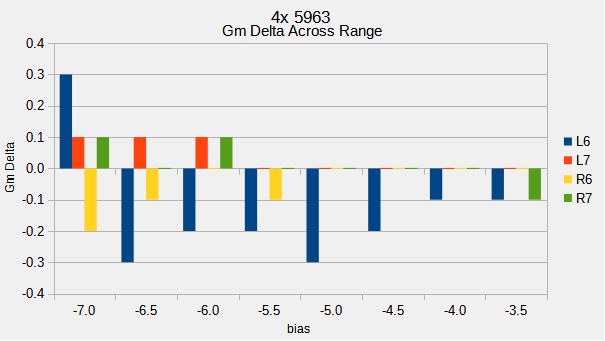
The images below are for a 12AU7 with 'perfectly' matched halves and 4x 5963 measured with an AkitikA 2PPM Sine Generator 0.002% signal source and a distortion analyzer in an amplifier gain board with no feedback. ALL tubes are NOS... NOT that it matters as NEW tubes could equal or exceed their performance.
The first graph keeps the 12AU7 driver and swaps the 5963 for the phase splitter. The second graph uses the 12AU7 for the phase splitter and swaps the 5963 for the driver tube.
Distortion varies little and its audibility is debatable. However, the gain deltas will be clearly audible.
NOTE: these graphs are at a single frequency [1kHz] and in a single board. Add in channel to channel component vagaries, power supply deltas, bias points and inherent tube frequency response inconsistencies, the probably of rolling transferability between systems approaches zero.
One may like the way a particular tube combination sounds in one's system, but it is wholly irresponsible to claim transferability. One user may have 1000 hours on their drivers and and another 4000 with completely different topology, power tubes, output transformers, feedback point and value. Speakers alone have a greater effect on the sound when combined with a particular output transformer.
The first graph keeps the 12AU7 driver and swaps the 5963 for the phase splitter. The second graph uses the 12AU7 for the phase splitter and swaps the 5963 for the driver tube.
Distortion varies little and its audibility is debatable. However, the gain deltas will be clearly audible.
NOTE: these graphs are at a single frequency [1kHz] and in a single board. Add in channel to channel component vagaries, power supply deltas, bias points and inherent tube frequency response inconsistencies, the probably of rolling transferability between systems approaches zero.
One may like the way a particular tube combination sounds in one's system, but it is wholly irresponsible to claim transferability. One user may have 1000 hours on their drivers and and another 4000 with completely different topology, power tubes, output transformers, feedback point and value. Speakers alone have a greater effect on the sound when combined with a particular output transformer.
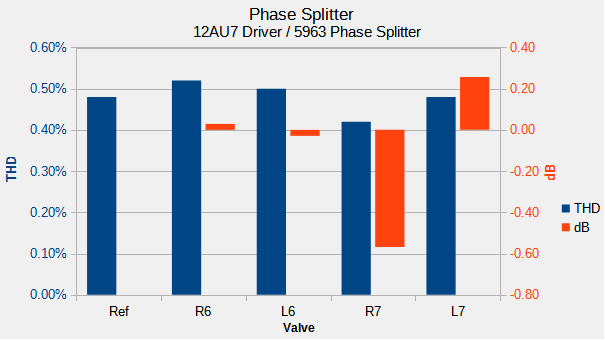
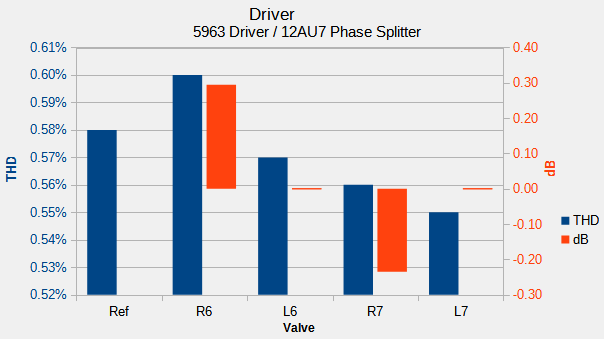
Power Output
If I had a dollar for everyone who has stated that putting KT120 vs KT88 in an amp results in more power, I could replace tubes annually! Power is determined by the power transformer. FULL STOP!! The power transformer supplies the current and the tubes regulate it. See KT88 6550 KT120 KT150 Tube Interchangeability at Blueglow Electronics on UBoob. [The origin of this myth is likely from replacing worn out 6550/KT88 w KT120.]
Assuming the circuit is properly designed and the tubes are functional, changing tubes may change the gain and/or frequency response. If the SPL is louder at the same input level, almost all perceive it as better.
Assuming the circuit is properly designed and the tubes are functional, changing tubes may change the gain and/or frequency response. If the SPL is louder at the same input level, almost all perceive it as better.
6550/KT88 vs KT120
- • The KT120 draws about 15% more heater current, so depending on the heater supply design this may be a benefit or a detriment. COLD heaters risk heater and cathode poisoning as the getters are less effective at lower temperatures.
- • The KT120 datasheet shows curve non-linearities not present in the KT88. Depending on the amp design and the program, this could be a positive or a negative.
Plate Curves
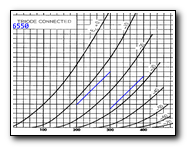
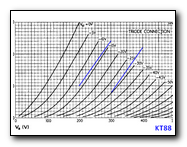
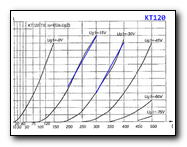
Click thumbnails for a larger image.
ESC or Click Upper Right 'X' to close.
ESC or Click Upper Right 'X' to close.
The plate curves have load lines in blue for I/V values of 100mA/200V to 250mA/300V and 80mA/300V to 220mA/400V. Note that these lines are merely illustrative as they exceed the tube SOA.
One can clearly see the kinks in the KT120 plate curve vs lines drawn at the same I/V slope, relative to the KT88 & 6550. Naturally this alone will make the KT120 sound different and vary with load depending if the kink is rising or falling relative to the load and V/I curve. "Better" is another matter entirely depending on the actual operation point. Whether the designer is better off using 2x 6550/KT88 or 1x KT120 likely to be subjective. Bias will add yet another parameter and shift the operation point along the plate curve.
Most tubes do not exhibit kinks in their datasheet plate curves. However, they have different parameters which consequently affect the sound. As all things audio, performance is Design AND System Dependent. What makes one system dulcet may make another dreadful. IOW, six nines [99.9999%] of all online audio advice relative to your system is highly suspect.
One can clearly see the kinks in the KT120 plate curve vs lines drawn at the same I/V slope, relative to the KT88 & 6550. Naturally this alone will make the KT120 sound different and vary with load depending if the kink is rising or falling relative to the load and V/I curve. "Better" is another matter entirely depending on the actual operation point. Whether the designer is better off using 2x 6550/KT88 or 1x KT120 likely to be subjective. Bias will add yet another parameter and shift the operation point along the plate curve.
Most tubes do not exhibit kinks in their datasheet plate curves. However, they have different parameters which consequently affect the sound. As all things audio, performance is Design AND System Dependent. What makes one system dulcet may make another dreadful. IOW, six nines [99.9999%] of all online audio advice relative to your system is highly suspect.
gambling in Monte Carlo
Simulation software often has Monte Carlo analysis. This emulates the circuit at part tolerance extremes for comparison to nominal values. Well designed circuits are relatively immune, but some require close tolerance parts in some areas to function to design.
One reads online of audiophools swapping tubes willy-nilly in their amplifiers searching for audio nirvana. It's largely a fools errand. With the M-125 and its four power tubes, there are 24 ways to arrange in one amplifier. Each will vary slightly.
Ditto 4x 12AU7 in both amps:
Combinations of eight tubes in two amps? 40,230!!!
If you love the way your amps sounds, indelibly identify the tubes so they may be returned to the correct location.
One reads online of audiophools swapping tubes willy-nilly in their amplifiers searching for audio nirvana. It's largely a fools errand. With the M-125 and its four power tubes, there are 24 ways to arrange in one amplifier. Each will vary slightly.
Ditto 4x 12AU7 in both amps:
{v1L,v2L,v1R,v2R} {v1L,v2L,v2R,v1R} {v1L,v1R,v2L,v2R} {v1L,v1R,v2R,v2L}
{v1L,v2R,v2L,v1R} {v1L,v2R,v1R,v2L} {v2L,v1L,v1R,v2R} {v2L,v1L,v2R,v1R}
{v2L,v1R,v1L,v2R} {v2L,v1R,v2R,v1L} {v2L,v2R,v1L,v1R} {v2L,v2R,v1R,v1L}
{v1R,v1L,v2L,v2R} {v1R,v1L,v2R,v2L} {v1R,v2L,v1L,v2R} {v1R,v2L,v2R,v1L}
{v1R,v2R,v1L,v2L} {v1R,v2R,v2L,v1L} {v2R,v1L,v2L,v1R} {v2R,v1L,v1R,v2L}
{v2R,v2L,v1L,v1R} {v2R,v2L,v1R,v1L} {v2R,v1R,v1L,v2L} {v2R,v1R,v2L,v1L}
{v1L,v2R,v2L,v1R} {v1L,v2R,v1R,v2L} {v2L,v1L,v1R,v2R} {v2L,v1L,v2R,v1R}
{v2L,v1R,v1L,v2R} {v2L,v1R,v2R,v1L} {v2L,v2R,v1L,v1R} {v2L,v2R,v1R,v1L}
{v1R,v1L,v2L,v2R} {v1R,v1L,v2R,v2L} {v1R,v2L,v1L,v2R} {v1R,v2L,v2R,v1L}
{v1R,v2R,v1L,v2L} {v1R,v2R,v2L,v1L} {v2R,v1L,v2L,v1R} {v2R,v1L,v1R,v2L}
{v2R,v2L,v1L,v1R} {v2R,v2L,v1R,v1L} {v2R,v1R,v1L,v2L} {v2R,v1R,v2L,v1L}
Combinations of eight tubes in two amps? 40,230!!!
If you love the way your amps sounds, indelibly identify the tubes so they may be returned to the correct location.
